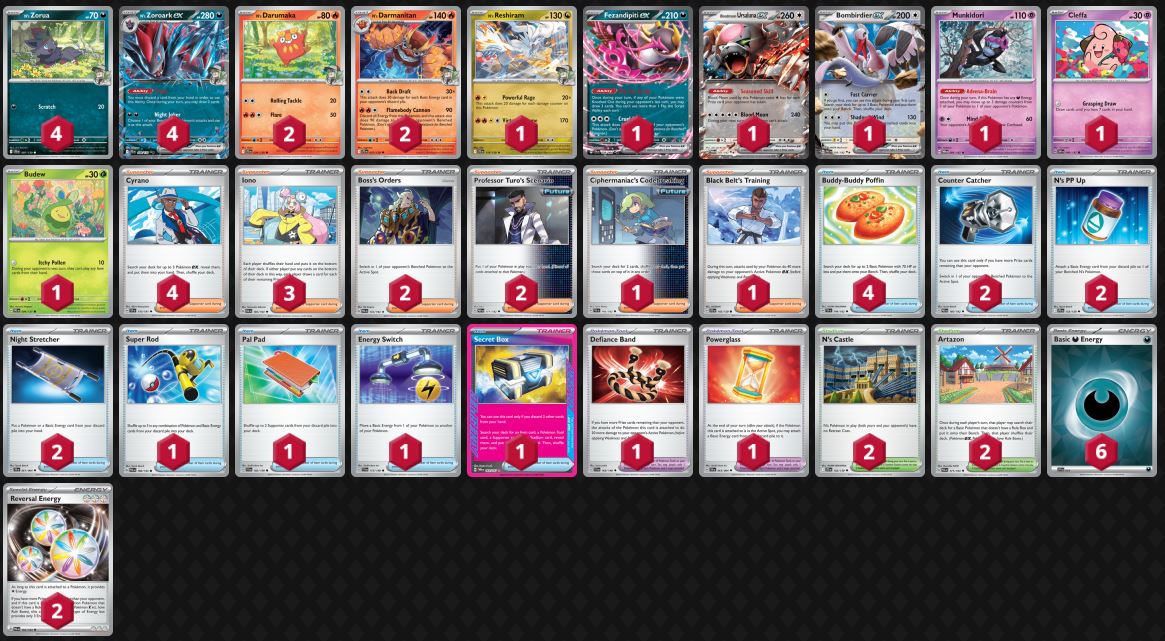Hey everyone, I’m a writer for Cut or Tap, currently ranked 6th in North America for the 2025 season. While Milwaukee was possibly my worst event of the season, the Zoroark deck my group worked on had a standout performance. Zoroark has seemingly come out of nowhere in recent weeks. While the deck is inherently very strong despite its low metagame percentage, it is one of the hardest decks to play in the current format. In this article, I’ll discuss how the list came to be, why certain cards are included or not, and how to play certain positive matchups which I view as the driving force to play the deck. I’ll be mainly referring to Lucas Xing’s 9th place list for my analysis, but the deck has multiple flexible spots for other inclusions you may want to try.
Zoroark’s Initial Success
With the release of Journey Together, while multiple entire decks left the format at the hands of rotation, none of the newly-released decks featuring the new mechanic ‘Trainer’s Pokemon’ looked to be especially strong. Certain cards, like Lillie’s Clefairy ex were set to and have had a very large impact on the format, but for the most part, the Trainer’s Pokemon mechanic looked to be largely a flop. While a version of N’s Zoroark was able to make Top Cut at the Champion’s League Fukuoka, upon the card’s release in the West, the deck saw virtually no success.
That was until the Sevilla Special Event, where British player Harvey Scheinman was able to make Top 4 with a build of N’s Zoroark featuring Professor’s Research and Prime Catcher. After this placement, the general player base began to view Zoroark as a rogue but serious threat to watch out for, and shortly following Sevilla, the deck established itself as a serious contender at Milwaukee, claiming two Asymmetrical Top Cut placements and taking down the Seniors division. Almost all the successful lists in Milwaukee were quite similar, relying on a Cyrano engine created by Liam Halliburton, with slight changes to the list he had been playing on ladder and given to Jeremy Gibson who finished Top 64 at Atlanta.
Joltik Box
Unfortunately for N’s Zoroark, its rise was matched with the extremely untimely rise of Joltik Box, a rather large thorn in the side of N’s Zoroark’s otherwise tremendous matchup spread. While Zoroark is a deck that essentially relies on making at least somewhat of a comeback every game with little early aggression, the speed at which Joltik Box is able to threaten N’s Zoroark’s board is frequently too difficult to deal with, with N’s Zoroark usually having no great response to Iron Hands ex on their second attacking turn. The matchup wouldn’t be as bad if for some reason Joltik Box didn’t also play both Galvantula and Iron Leaves ex, providing Joltik Box with two very easy options to just knock out an N’s Zoroark ex without having to use Pikachu ex’s Topaz Bolt and weaken their board by discarding energies. N’s Zoroark really needs to try and knock out the Joltik as quickly as possible to limit how many energies they can put into play while also denying them the opportunity to use the one-prize Galvantula.
Unfortunately for me, I was cursed with two Joltik Box in my opening six rounds at Milwaukee, and combined with a double-brick to Eevee Box where I did not manage to get a Zoroark into play either game, my tournament run was cut rather short. However, Lucas Xing was able to place 9th with a list one card off the list Liam Halliburton helped me decide on for the tournament, with Lucas’s list playing a copy of Energy Switch over the fourth copy of Iono that I played. Despite the relatively newfound prevalence of Joltik Box, N’s Zoroark retains lots of very strong matchups, with almost nothing besides Joltik being worse than a 50/50 matchup.
Breaking Down the List

After upgrading your membership, you will see the rest of the article, and an audio recording of this article, narrated by Andy Hyun:  You must have a Premier Membership or greater to see the rest of this post. If you don't have a Premier account, you can Sign Up for one here.
You must have a Premier Membership or greater to see the rest of this post. If you don't have a Premier account, you can Sign Up for one here.
 You must have a Premier Membership or greater to see the rest of this post. If you don't have a Premier account, you can Sign Up for one here.
You must have a Premier Membership or greater to see the rest of this post. If you don't have a Premier account, you can Sign Up for one here.
